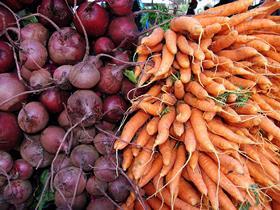
Prior to the current heatwave, wet and cold weather had been dampening the mood of growers in several vegetable crops, with rain delaying plantings and potentially causing shortages later in the season.
It is not all doom and gloom, however, with value sales across the category rising 5.7 per cent in the year to 25 March. This is thanks, in large part, to higher average prices, which have added £93.9 million to the category, according to Kantar.
In carrots, Guy Poskitt of MH Poskitt says the drilling of the new crop has been “relatively on time” at his farm in the East Riding of Yorkshire, but their development has been “very slow” due to cold soil temperatures, delaying production by about two to three weeks compared to a normal year.
Second earlies, meanwhile, are “virtually non-existent”, Poskitt says, and this is likely to create a gap in the market towards the end of July and into August, he predicts. “I would say the availability of second earlies will be very, very restricted,” the Yorkshire grower says. “With maincrop drillings there’s a long way to go yet but it’ll take more than just one nice day to dry the fields up. The land is absolutely saturated.”
The farmer’s previous crop was also significantly tightened by “really bad weather”, with high levels of rotting and huge demand from Europe taking “all the slack” out of the UK market. “Everybody has been very challenged in terms of damage to the land,” he says. “When you get towards the end of the season, the number of fields you can lift reduces so the lifting is a huge challenge. The impact on farmers’ fields is massive. The old crop yields are good but the availability of land to lift is very, very restricted due to the wet weather.”
When it comes to sales, the outlook is more positive, with strong promotional activity at Easter driving up volumes. But the question going forward will be whether Europe can produce enough carrots in the summer to fill a potential shortfall in UK production. As it stands, Spain, France and Poland are all struggling with their carrot supply, says Poskitt, and the Netherlands has seen low gradeout on its stored carrots.
Meanwhile, the loss of agrochemicals such as linuron will present a further challenge to growers, with sales of the herbicide ending last year and the deadline for the disposal, storage and use of existing stocks set for June 2018. A potential replacement called metobromuron, along with five other chemicals, are being tested by AHDB as part of its SCEPTREplus trials.
Another product affected by the wet spring weather is beetroot, with half of planting yet to be completed. “It’s not looking good at present because all we keep getting is wet, wet, wet,” says Red Star Growers marketing director Andrew Hartley. “Because of the extremities of the weather it’s all been put back, but if we get a dry period, that shortfall of planting could be made up to a degree.”
In purple sprouting broccoli, meanwhile, the main difficulty has been the timing of frosts in the current season. “Normally the over-winter product is encouraged to grow by frosts,” explains Hartley, “and although we’ve had a number of frosts this year, it’s been very hit and miss.” Ideally, growers want frosts to hit in late November and December, but this year they didn’t come early enough, delaying the season by four weeks in some regions and longer in others. “Everything’s running late and we’re harvesting product now that should’ve been harvested a month ago,” Hartley says.
Despite this, the market for purple sprouting is in good shape, with value sales growing year on year. The rise in demand for Tenderstem is potentially an issue for the vegetable, Hartley ventures, but the premium brassica only appears to be cannibalising sales of purple sprouting broccoli during the UK summer when it is competing against homegrown Tenderstem.






No comments yet